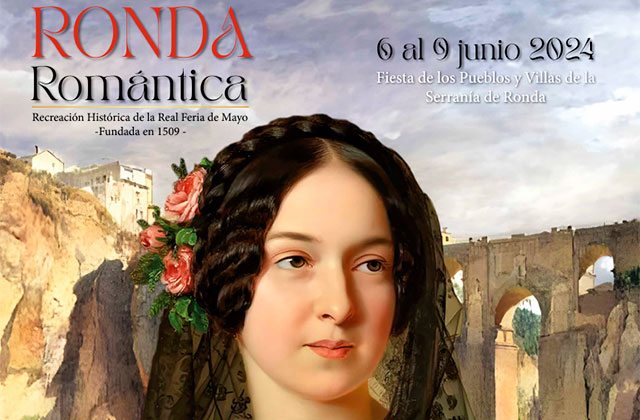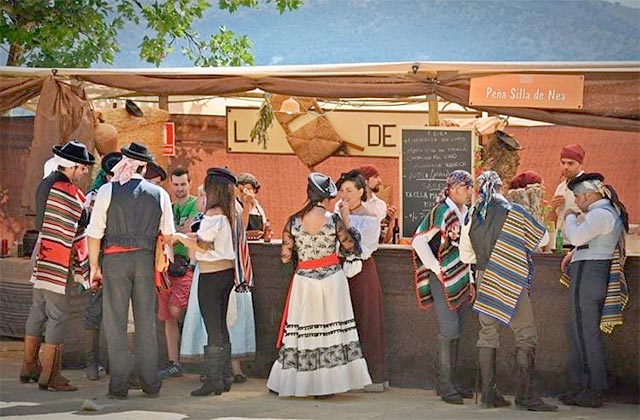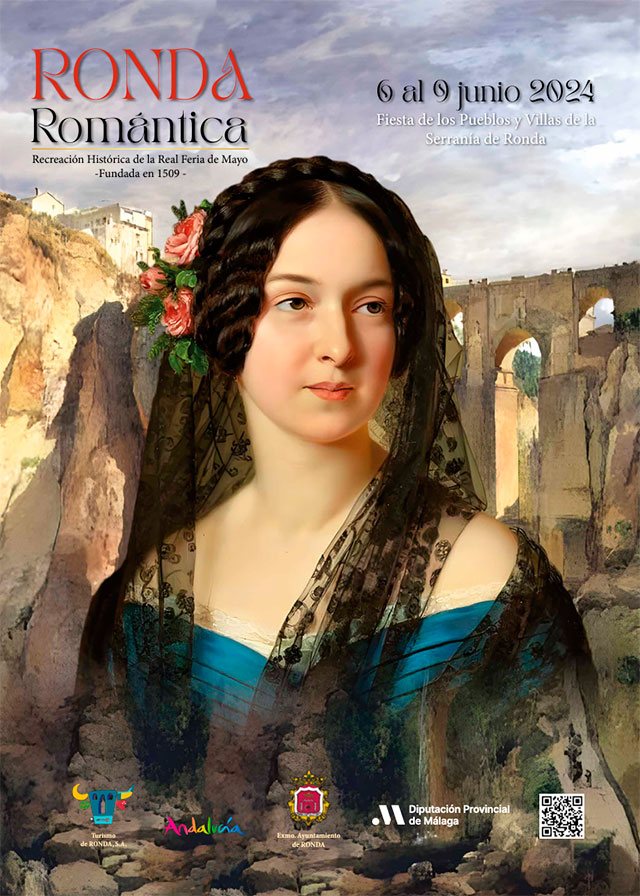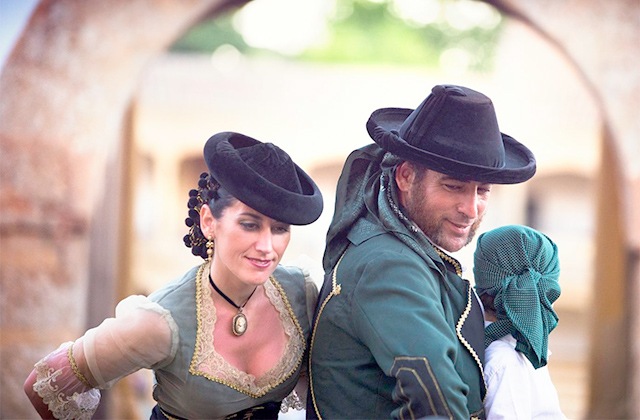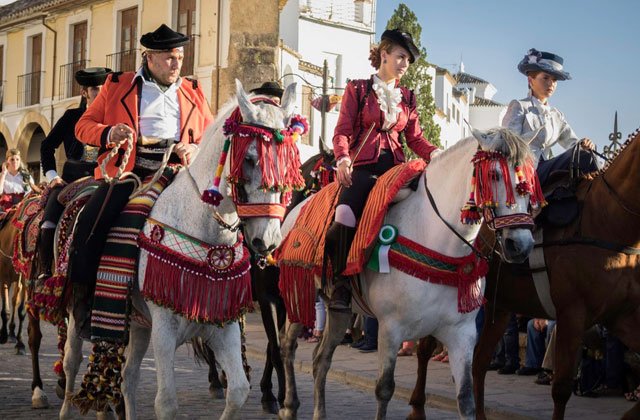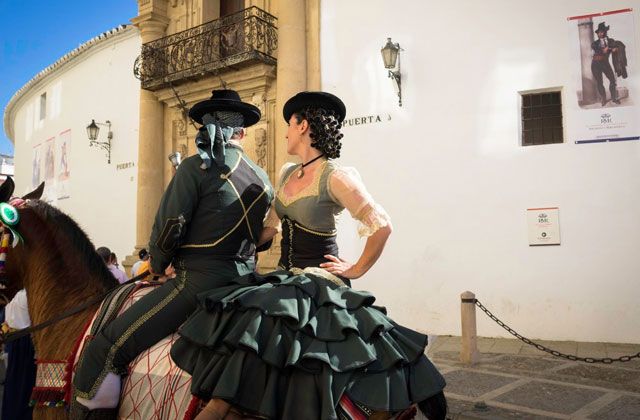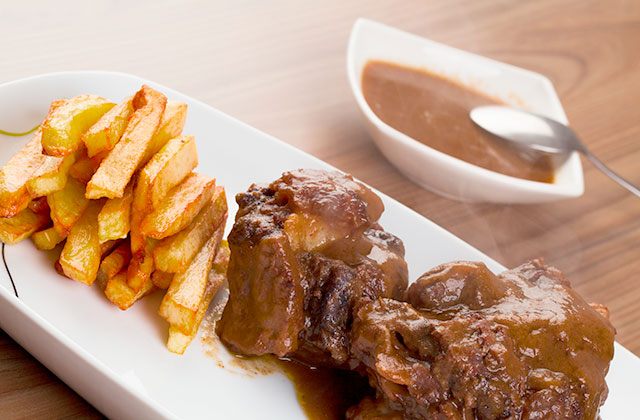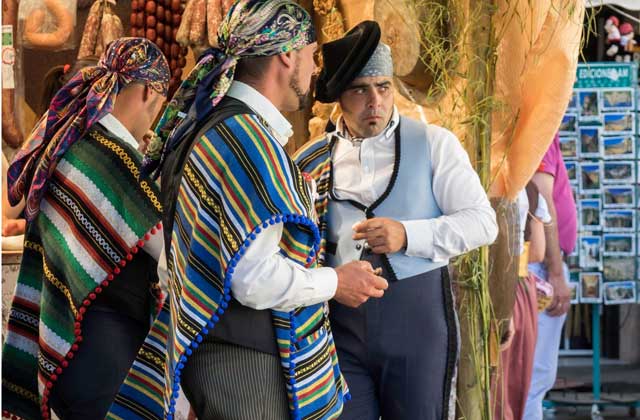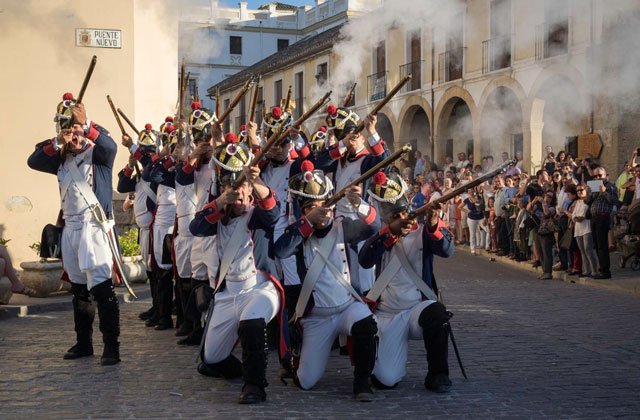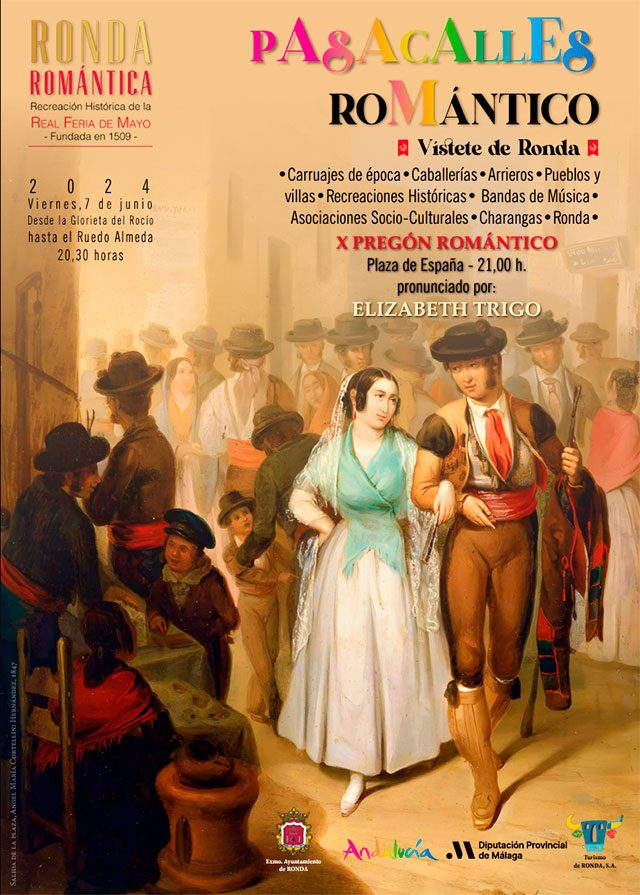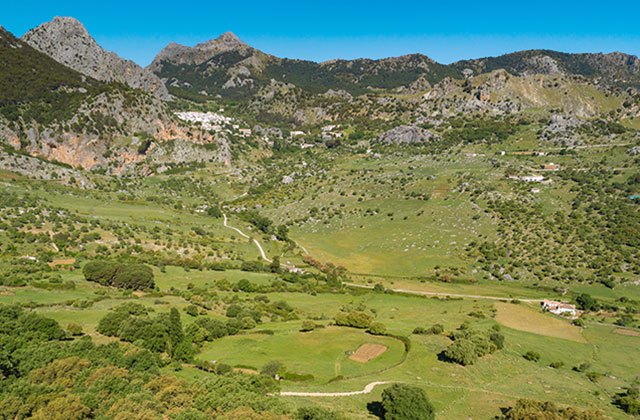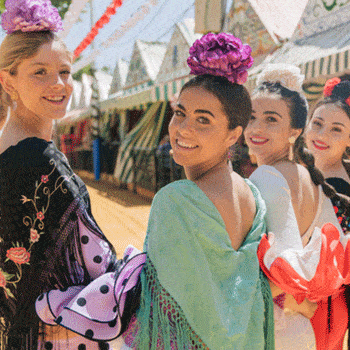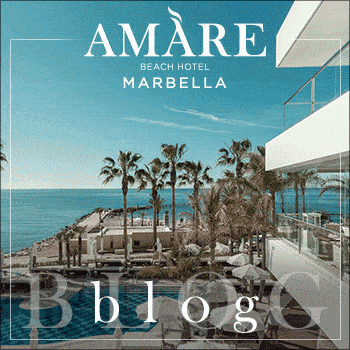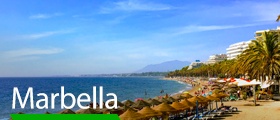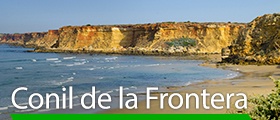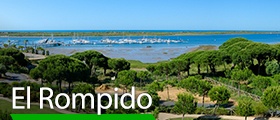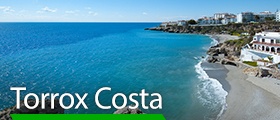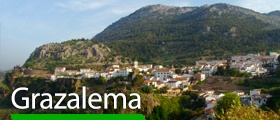
Historical recreation full of color and tradition: visit the Romantic Ronda 2024
Travel in time to the Ronda Romántica that will take place this year from June 6th to 9th. Five very important days in tourism in Ronda since both citizens and many visitors move to those historical moments in which the first editions of the Royal May Fair were held, back in the sixteenth century. During this party, in Ronda you can enjoy the cattle, equestrian exhibitions and especially taste the most emblematic products of the area (wines, sausages, cheeses etc.), buy in the market of agro-food and artisan time, enjoy with the parades and an endless number of other activities that will take us back to other time.
Activities during the “Ronda Romantica” 2024
During this particular festivity you can enjoy the most traditional dishes of Serrania, delight yourself with great exhibitions of both horses and livestock or see the different parades with typical dresses of the time such as the Goyescas. It is also very normal in this party that the neighbours decorate both the streets and their balconies so you will surely see different shawls along the different streets of the centre.
It is also necessary to say that as the party takes place around the neighbourhood of San Francisco, if you decide to go by car the city has enabled a parking area at the entrance, so you will not have problems leaving the car.
Official Program and Activity Schedule at Each Venue
Thursday, June 6th, until Sunday
- Romantic Market
- Plaza Duquesa de Parcent
- Plaza Pérez Clotet
- Murallas del Almocábar
- Plaza Ruedo Alameda
Friday, June 7th
- 12:30 PM – Children’s Parade for Schools
- From Avenida Martínez Astéin to Alameda
- 8:30 PM – Ronda Romántica Parade
- 9:00 PM – Opening Speech by Elizabeth Trigo
- Plaza de España, Parador de Turismo
- 10:00 PM – Flamenco Encounter of Ronda Songs
- Singers: Antonia Contreras and Paco Pereña
- Guitarists: Ángel Mata and Miguel Laín
- Murallas de Almocábar
- 10:30 PM – Equestrian Exhibition
- Plaza Duquesa de Parcent
- 10:30 PM – Historical Reenactments
- Atrio Virgen de Gracia
- 11:15 PM – Romantic Ambient Music by Charanga Tuba de Sevilla
- Murallas de Almocábar
- 11:30 PM – Flamenco Encounter of Ronda Songs
- Atrio Virgen de Gracia
Saturday, June 8th
- 11:00 AM – Horse and Carriage Ride
- Plaza de España to Plaza Ruedo Alameda
- 11:30 AM – Equestrian Exhibition
- Plaza Duquesa de Parcent
- 12:30 PM – Historical Reenactments of the Towns
- Atrio Virgen de Gracia
- 12:30 PM – Children’s Games and Performance by A Tu Vera
- Rest areas and walls
- 2:30 PM – Tribute to the Golden Romantic. Tuna from the Technical Architecture School of Granada
- Plaza Duquesa de Parcent
- 10:30 PM – Flamenco Encounter of Ronda Songs
- Las Murallas
Sunday, June 9th
- 12:00 PM – Performance by the Choirs and Dances of Ronda
- Atrio Virgen de Gracia
- 12:00 PM – Historical Reenactment
- Atrio Virgen de Gracia
- 12:30 PM – Equestrian Show
- Plaza Duquesa de Parcent
More details on this portal and at rondaromantica.net
Curiosities about the Ronda Romántica
- Origins of the festival: The Ronda Romántica began as a small celebration organized by a group of friends who wanted to honor the romantic era of the city. Over time, the festival has become one of the most important events in Ronda.
- Costumes and clothing: During the Ronda Romántica, the city’s residents and visitors dress in typical romantic-era costumes.
- Activities and events: The Ronda Romántica offers a wide variety of activities and events, such as concerts, exhibitions, parades, historical reenactments, and street performances. One of the most important moments of the festival is the “Dance of the Giants,” in which people dance around huge papier-mâché figures.
- The queen’s election: Every year, a queen of the Ronda Romántica is chosen to represent the city and be the main figure of the festival. The election takes place in a competition in which young women from the city participate.
- Community participation: The Ronda Romántica is a very participatory festival in which the community actively gets involved in the organization and development of the events. The city’s residents work together to create costumes, decorate the streets, and organize the performances.
- Touristic importance: The Ronda Romántica is one of the most important events of the year for the city of Ronda, and attracts thousands of tourists every year. The festival is an opportunity for visitors to learn more about the history and culture of the city, as well as enjoy its natural and architectural beauty.
- Recognition: The Ronda Romántica has received numerous awards and recognitions over the years, including the Andalusian Tourism Award and the Special Mention of the Jury at the European Cultural Tourism Awards.
REASONS FOR VISITING THE ROMANTIC RONDA
1. The ‘Romantic’ setting
The setting recreated by the Romantic Ronda is simply amazing. Locals truly express themselves by decorating their streets and shop windows. The garlands and oleanders in the streets mix with pennants and banners hanging from the lampposts, exhibiting the heraldry symbols of Ronda’s mountain region. A tour to the most genuine history of the city. Stores dress up in the fashion of the Romantic times, paying attention to every detail. So, there you can find etchings that recreate the most typical moments of the time, which are very successful with visitors. Bulls and horses next to men and women dressed as “majas and majos” is another typical image that many painters have reproduced in their canvas.
But the fair is not only about these artistic expressions displayed by art galleries. Emphasis is put on the setting, through the typical agricultural tools of the time. Wheelbarrows, rakes and tools for animals are just a few examples of what we can find. All of this is also accompanied by clay objects, flowerpots, heaters, bowls, vases, barrels, chests, trunks, vessels, nickel silver, antique furniture and tables .
As for restaurants, cooking will be made in stone ledges, and food can be prepared only in stoves or portable cookers. There will be no electric light, and light will be obtained from oil lamps, kerosene lamps or candles. Chairs and tables are made from rustic wood, boards or cattail.
This effort turns Ronda into the center of attention during one of its most traditional celebrations. For this reason, contests are also held, giving prizes to the best decoration, the best typical dish, or the best costume, and others.
2. Men and Women of the Time
One of the most prominent features of Romantic Ronda is the typical dress of the time worn by local people, disguised as the “majas and majos” from this remembered time . Both in men and women, attires are eye-catching and significant, a mixture of elements of different origins, and some of them can date way back to the past.
Women wear a traditional dress in lively colors that goes down to their ankles, with socks and buckled shoes. They wear a very tight doublet with lapels and narrow sleeves, adorned with embroidery in the shoulder area, oftentimes with many silver buttons. The main color of this garment used to be black, inherited from the Austrias monarchy, as it was worn by the court. In the colored area they used to put some kind of adornment, this is, friezes and velvet straps adorned with tassels. The hair, always pinned up inside a bonnet was another particular feature of these Ronda “majas”, and many times it was also adorned with tassels.
For their part, men wore a coat with elbow guards, also called Marseille coat because it looks like the garment used by French soldiers in Marseille. They wear a “calzón”, that is, trousers which are tight in the upper and lower part, but looser in the middle, ending up with buckled shoes that left the socks uncovered. They wear a belt around the waist, and their hair with long side whiskers.
With these main details, current Ronda locals make their costumes for the occasion, and many of them take the opportunity to dress up as bandits, the main assaulters of the 19th Century , who hid in the Ronda Mountains. An unbeatable show to commemorate this historical recreation based on clothes.
3. Gastronomy of the Past
If you are coming to Ronda, prepare your palate to discover the most delicious flavors, especially at this time of celebration, when tables are filled with typical recipes of the time. Without a doubt, Ronda has always been famous for its cold meats like the chorizo (spicy sausage), Spanish sausage, bondiola, pork loin, ham, foreleg and morcon (blood sausage). The oxtail, the stuffed head of loin, and the Ronda-style kid are some of the most typical recipes of the region.
During the Romantic Ronda fair, stores compete with each other to get first prize to the best typical dish, and so you can embark on a genuine gastronomic tour and taste the specialty of each place, all prepared in the traditional style, using stoves or portable cookers.
Desserts are another delicacy that stands out, and they are prepared with products from Valle del Genal like chestnuts or almonds. One more reason to come to Ronda in late May.
4. Horses and History
Horses and History
The importance of livestock in this region dates back to the Muslim Times, when Ronda was the top producer of sheep and goats within the Kingdom of Granada, and it was then known as “The Mountains of Wool”. In some way it remained so after the Castilian conquest, without neglecting cows and horses. It is precisely horses that continue to stand out in this region. Always popular, but particularly in the 19th Century, these animals have been side by side with Ronda’s local people.
During this festival, the attire worn by horses is also recreated, together with the rider’s outfit. So, the horse wears a packsaddle, a typical country item. The saddle is adorned with brakes and breast-straps. The head stall was usually made from leather, and overall the attire was very colorful.
The rider wears a calañes hat with a silk handkerchief below, pinning up the hair in a knot close to his left year, and leaving the rest of the hair loose. In the torso, a white tight shirt and a vest in sober colors. The sash, in this case also dark, was worn around the tight trousers. Finally, on their feet they wore ankle boots covered by gaiters.
If you like horses, this is a great moment to see the best specimens, while you enjoy seeing the clothes of that time. It is a must-see spot for those who love Romanticism.
5. Pasacalles
Ronda is filled with parades, street vendors and artisans during these days that evoke the city’s romantic past, complete with recreations of the guilds, taverns and historic parts of the town. Ancient salesmen selling coal, ice and water can be found guiding their donkeys and carts through traditional markets.
The region’s traditional period dress will also be on display as residents wear costumes from ages long since passed, recreating the roles of their ancestors.
Further, the neighborhoods will take a special effort to decorate each corner of the town behind campaigns like “No Balcony Without a Shawl”, in which every balcony in Ronda will become an exhibition of embroidered silk shawls and damask fabrics.
6. Historical Re-enactment
The town’s re-enactments should not to be missed, providing a chance for visitors to watch a historically accurate performance of ‘The Battle of the Bridge’, ‘The French invasion, 1810’, ‘Moors and Christians’,’ Ronda Contribution to Parliament of 1812 ‘Bandoleros de Grazalema ‘and a song and dance to “Dancing Round The Mountain”.
But that’s not all, because “Romantic Ronda” offers many more activities, including the First Congress of Travelers and Banditry in the Serrania de Ronda, ‘Expobandolero’ and the film exhibition, ‘Cinebandolero‘. In addition, the streets will host horse shows, horse riding, burro rides, fixed and street theater performances, street music and endless romantic activities that take us in the Serrania de Ronda.
7. Sierra de Grazalema
The majestic city of Ronda is only 40 minutes from Sierra de Grazalema Natural Park. If you want to take a quick trip by late May and early June, you can disconnect from all problems at Grazalema and, on the day of the festival, come to the most romantic city in Malaga: Ronda. There is no better option to clean one’s lungs with pure air while enjoying the most deeply-rooted traditions at the same time.
If you come here you can enjoy the thick Mediterranean forest of holm oaks, cork oaks and gall oaks, as well as its most typical species: the Spanish fir. Mainly concentrated in Sierra del Pinar, as it is the rainiest place in the Peninsula, this species descends from the Central European firs, which formed large forests here during the Ice Ages. Today, these firs live only here, at the Sierra de las Nieves and Sierra Bermeja Natural Parks (both in the province of Malaga), hence their uniqueness. Visit dream-like places to practice any kind of outdoor sports for all tastes. Mountaineers can ascend to peaks like El Torreón or El Reloj, or climb rocky grounds and walls in Peñón Grande, Aguja de las Palomas and Peñaloja, in Grazalema. A perfect plan to combine both interests: nature and culture.
If you have read these 5 features of the Romantic Ronda, we are certain that this plan will not leave you indifferent. Enjoy the South of Spain in its greenest landscapes, while taking part in the most well-known and picturesque celebrations.
Ronda: 10 things to see beyond the Tagus
The best tapas bars and restaurants in Ronda
Ronda’s Pedro Romero fair and Goyesca bullfight
WHERE TO STAY
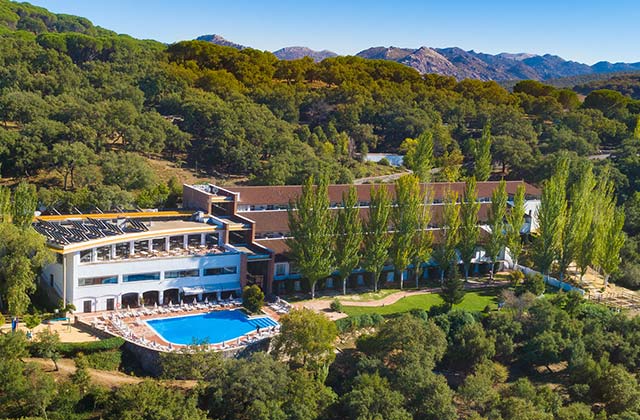
Hotel Fuerte Grazalema
If you want to experience this Romantic Ronda firsthand and also fill your lungs with pure air, the best place to stay, without a doubt, is Fuerte Grazalema.
The hotel has 77 rooms equipped with private balcony, breathtaking views to the Guadalete Valley and the town of Grazalema, air conditioning, satellite TV, mini-bar, free Wifi, bathroom with amenities and hairdryer.
It has an outdoor swimming-pool and a jacuzzi with views to the Sierra de Grazalema. Besides, this is one of the few hotels in the area with a game room. It also houses an animal farm and an organic garden, with visits every day organized by the hotel. Other activities in the program for guests to enjoy include courses of Andalusian cuisine, tasting of regional dishes, flamenco classes, and workshops on how to prepare sangria and gazpacho.
Hotel Fuerte Grazalema – Ronda
